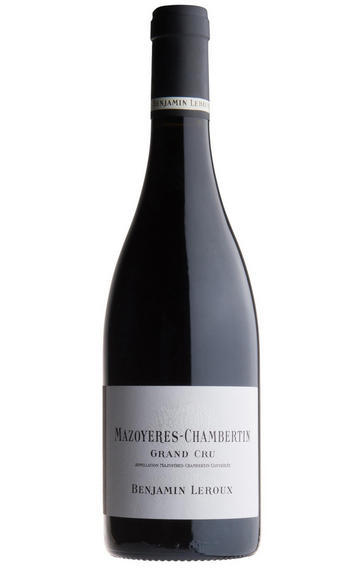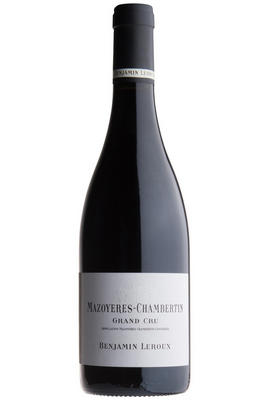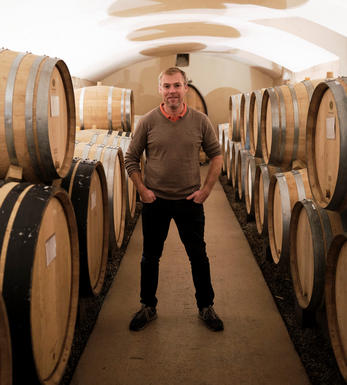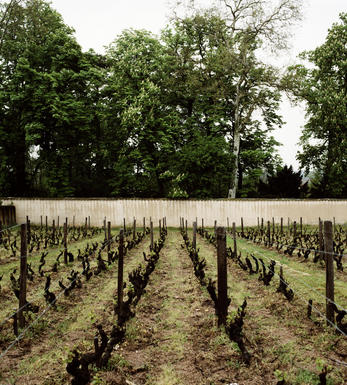
2014 Mazoyères-Chambertin, Grand Cru, Benjamin Leroux, Burgundy

Critics reviews
Relatively subtle wood treatment allows the notably floral red berry fruit, humus and earth-inflected aromas to shine. There is excellent volume to the delicious and tension-filled medium-weight plus flavours that exhibit fine depth and length on the moderately austere and saline-inflected finish. This is quite firm and somewhat rustic and the supporting tannins aren't especially refined, so once again patience will be required.
Drink from 2026 onward
Allen Meadows, Burghound.com (April 2016)
The 2014 Mazoyres-Chambertin Grand Cru has a sublime bouquet, quite cohesive and floral with gorgeous blackberry, raspberry coulis and cranberry. The palate is medium-bodied with fine tannin, a natural balance, exquisite poise and length. Just a delectable Grand Cru that really shines in this vintage, unequivocally one of Benjamin Leroux's standout 2014s.
Drink 2018 - 2038
Neal Martin, Wine Advocate (December 2015)
Bright, full red. Red cherry, rose petal and mint aromas are accented by a stony element. Boasts terrific cut and purity to its cherry, mineral and mint flavours. Very classy for Mazoyères but still youthfully tight, and showing little in the way of early sweetness. Still, this is rather feminine in style for Mazoyères. The edgy tannins will require patience.
The talented Benjamin Leroux, who now makes roughly 60,000 bottles each of red and white wine annually, described the 2014 reds as "sweet and appealing wines that can be enjoyed young, before the 2013s. But they're well-balanced and they should age well," he added."They are not light wines." It's also a classic vintage, he told me, especially compared to 2015, which featured some of the lowest levels of malic acidity to date, and 2013, which began with the highest malic acidity in his winemaking career. Potential alcohol levels were in the very healthy 12. 5% to 13% range in 2014, and Leroux did almost no chaptalization.
Leroux vinifies with a significant percentage of whole clusters, particularly for his grand crus, but this decision is made for each wine on the sorting table; in 2014, for example, he entirely destemmed his Clos Saint-Denis and Mazoyères-Chambertin. The entry-level wines here get no more than 10% new oak, the premier crus about 20%. For the grand crus, the percentage of new oak depends on the volume of wine. A majority of the 2014s were racked and blended just before the 2015 harvest.
Stephen Tanzer, Vinous.com (January 2016)
About this WINE

Benjamin Leroux
Having created a name for himself as régisseur (general manager) of Domaine du Comte Armand in Pommard, Benjamin Leroux established, with English backing, a small négociant business based in Beaune since 2007. The range is confined to the Côte d’Or, from Chassagne-Montrachet to Gevrey-Chambertin, with the intention of developing farming contracts or indeed purchasing vineyards in the future.
The possibilities are very exciting for this exceptionally talented vigneron. Benjamin is a master at delivering purity of fruit alongside a seamless texture in his wines which have only the subtlest influence of oak. One of Benjamin’s favourite locations for white wine vineyards is the border between Auxey-Duresses and Meursault, which is where Les Vireuils can be found. Here the natural weight of Meursault is enhanced by the fresher minerality typical of the side valley of Auxey-Duresses.
Jasper Morris MW, Burgundy Wine Director and author of the award-winning Inside Burgundy comprehensive handbook.
Discover the story behind our Own Selection Bourgogne Côte d’Or Pinot Noir, made for us by Benjamin. Read more

Gevrey-Chambertin
Gevrey-Chambertin is the largest wine-producing village in Burgundy’s Côte d'Or, with its vineyards spilling over into the next door commune of Brochon.
Located in the far north of the Côtes de Nuits above Morey-St Denis, classic Gevrey-Chambertin is typically deeper in colour, firmer in body and more tannic in structure than most red Burgundy. The best can develop into the richest, most complete and long-lived Pinot Noir in the world. This is largely thanks to the iron-rich clay soils, though much depends on whether the vineyard is located on either the steeper slopes (Evocelles, Clos St Jacques) or the flatter, richer soils (Clos Prieur, Combottes).
Whereas in the past there have been numerous underperformers in Gevrey-Chambertin exploiting the reputation of this famous village and its iconic Grands Crus, today there are many fine sources to choose from, and overall quality is higher than ever.
Gevrey-Chambertin’s greatest Grand Cru is named after the field of the monk Bertin (Champ de Bertin). In 1847, Gevrey appended the name of this illustrious vineyard, Chambertin, setting a trend for the other principle villages to follow. Le Chambertin may not be quite as sumptuous as Musigny or Richebourg, or as divinely elegant as La Tâche or Romanée-St Vivant, but it is matched only by the legendary Romanée-Conti for completeness and luscious intensity.
In all, Gevrey boasts an impressive nine Grands Crus, with the name of Chambertin retaining a regal omnipresence throughout its finest vineyard names. The other truly great Grand Cru is Chambertin-Clos de Bèze which has the right to sell its wines simply as ‘Chambertin’, and is the only wine allowed to put the Chambertin name before, rather than after, its own. Situated slightly further up the hill, the wines are fractionally less powerful yet full of sensual charm and finesse.
Quality-wise the next best are generally acknowledged to be Mazis-Chambertin and Latricières-Chambertin. The former is incredibly concentrated and very fine, but its structure is a little less firm than Le Chambertin. Latricières is less about power (although it can be explosively fruity) and more about an entrancing silkiness.
Situated slightly higher up the slope, Ruchottes-Chambertin is impressively rich, stylish and slightly angular. The tiny Griottes-Chambertin, which owes its name to the grill-pan shape of the vineyard rather than the wine’s griotte cherry aroma, is lower down the slope and boasts a velvety texture and rich fruit reminiscent of Chambertin itself. It is generally better than the lighter, although wonderfully fragrant Chapelle-Chambertin and Gevrey’s largest Grand Cru, the pure and seductive (if variable) Charmes-Chambertin.
Gevrey also has some outstanding Premier Crus on the south-east-facing slopes above the town. Les Cazetiers and especially Clos St Jacques produce some exceptional wines. Indeed Armand Rousseau, who pioneered domaine bottling here in the 1930s and is still one of the region’s very best producers, often sells his Clos St Jacques for more than several of his Grand Crus.
Drinking dates for these wines vary, but Grand Crus are generally best from at least 10 to 25 years, Premier Crus from eight to 20 years, and village wines from five to 12 years.
- 315 hectares of village Gevrey Chambertin
- 84 hectares of Premier Cru vineyards (20 in all). The foremost vineyards include Clos St Jacques, Lavaux St Jacques, Combottes, Corbeaux, Cherbaudes, Cazetiers.
- 55 hectares of Grand Cru vineyards: Chambertin, Chambertin Clos de Bèze, Latricières-Chambertin, Ruchottes-Chambertin, Mazis-Chambertin, Charmes-Chambertin, Mazoyères-Chambertin, Chapelle-Chambertin, Griottes-Chambertin..
- Recommended producers: Bachelet, Dugat, Esmonin, Mortet, Rossignol Trapet, Rousseau, Serafin, Bernstein
- Recommended restaurants : Chez Guy (good wine list), Rôtisserie du Chambertin (and Bistro)

Pinot Noir
Pinot Noir is probably the most frustrating, and at times infuriating, wine grape in the world. However when it is successful, it can produce some of the most sublime wines known to man. This thin-skinned grape which grows in small, tight bunches performs well on well-drained, deepish limestone based subsoils as are found on Burgundy's Côte d'Or.
Pinot Noir is more susceptible than other varieties to over cropping - concentration and varietal character disappear rapidly if yields are excessive and yields as little as 25hl/ha are the norm for some climats of the Côte d`Or.
Because of the thinness of the skins, Pinot Noir wines are lighter in colour, body and tannins. However the best wines have grip, complexity and an intensity of fruit seldom found in wine from other grapes. Young Pinot Noir can smell almost sweet, redolent with freshly crushed raspberries, cherries and redcurrants. When mature, the best wines develop a sensuous, silky mouth feel with the fruit flavours deepening and gamey "sous-bois" nuances emerging.
The best examples are still found in Burgundy, although Pinot Noir`s key role in Champagne should not be forgotten. It is grown throughout the world with notable success in the Carneros and Russian River Valley districts of California, and the Martinborough and Central Otago regions of New Zealand.


Buying options
Add to wishlist
Description
Relatively subtle wood treatment allows the notably floral red berry fruit, humus and earth-inflected aromas to shine. There is excellent volume to the delicious and tension-filled medium-weight plus flavours that exhibit fine depth and length on the moderately austere and saline-inflected finish. This is quite firm and somewhat rustic and the supporting tannins aren't especially refined, so once again patience will be required.
Drink from 2026 onward
Allen Meadows, Burghound.com (April 2016)
wine at a glance
Delivery and quality guarantee